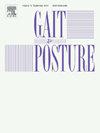ESMAC最佳论文2024:定义外骨骼目标问题:使用双层优化模拟具有明确目标的最佳辅助时刻
IF 2.2
3区 医学
Q3 NEUROSCIENCES
引用次数: 0
摘要
肌肉骨骼模拟可以指导寻找辅助运动的最佳策略,并揭示辅助时刻和肌肉动力学之间的因果关系。像外骨骼这样的辅助装置可以根据不同的目标来补充肌肉力量,比如最小的肌肉力量或最大的力量分布。在本研究中,我们提出了一个模拟框架来系统地识别最佳辅助,该框架被表述为单个逆模拟方案中的双层优化,该方案寻求满足不同辅助装置目标的最佳辅助时刻。方法将辅助力矩双层优化构建为一个内部优化问题,解决嵌套在外部优化问题中的肌肉冗余问题,外部优化问题迭代执行内部优化问题,寻求最能满足辅助目标的辅助力矩。我们使用这个框架来预测最佳的踝关节跖屈、髋关节伸展、髋关节屈曲和髋关节外展辅助,以达到三个不同的目的:最小的肌肉激活、最小的代谢率和最小的肌肉力矩。本研究使用了12名参与者以首选速度行走的实验数据。结果对于给定的辅助目标,最优力矩轨迹是唯一的;也就是说,辅助目标很重要。在肌肉水平上解释了辅助轨迹的差异,并作为主动和被动力对净肌肉力矩和肌肉机械功的贡献。有趣的是,最小代谢率的辅助时刻预测的辅助期和峰值时间与实验研究报告的相似。结论研究结果表明,需要明确的辅助目标制定来研究最佳辅助下的人-装置交互作用。本文章由计算机程序翻译,如有差异,请以英文原文为准。
ESMAC Best Paper 2024: Defining exoskeleton aim matters: Simulating optimal assistive moments with explicit objectives using bilevel optimization
Introduction
Musculoskeletal simulations can guide the search for optimal strategies to assist motion and reveal causal relationships between assistive moments and muscle dynamics. Assistive devices such as exoskeletons can complement muscle forces based on various aims, such as minimum muscle effort or maximal force distribution. In this study, we present a simulation framework to systematically identify optimal assistance, formulated as a bilevel optimization in a single inverse simulation scheme that seeks optimal assistive moments that fulfill different assistive device aims.
Methods
Bilevel optimization of assistive moment was structured as an inner optimization problem to solve the muscle redundancy problem nested within an outer optimization problem that executes the inner problem iteratively, seeking an assistive moment that best satisfies the assistive aim. We used this framework to predict optimal ankle plantarflexion, hip extension, hip flexion, and hip abduction assistance, for three different aims: minimal muscle activations, minimal metabolic rates, and minimal muscle moments. Experimental data from twelve participants walking at preferred speed were used in this study.
Results
We found that the optimal moment trajectory is unique for a given assistive aim; i.e., the assistive aim matters. Differences in the assistive trajectories are explained at the muscle level, and as active and passive force contributions to the net muscle moments and muscle mechanical work. Interestingly, the assistive moments for minimal metabolic rates predicted an assistance period and peak timing similar to those reported from experimental studies.
Conclusions
Our findings suggest that explicit assistive aim formulation is required to investigate human-device interaction under optimal assistance.
求助全文
通过发布文献求助,成功后即可免费获取论文全文。
去求助
来源期刊

Gait & posture
医学-神经科学
CiteScore
4.70
自引率
12.50%
发文量
616
审稿时长
6 months
期刊介绍:
Gait & Posture is a vehicle for the publication of up-to-date basic and clinical research on all aspects of locomotion and balance.
The topics covered include: Techniques for the measurement of gait and posture, and the standardization of results presentation; Studies of normal and pathological gait; Treatment of gait and postural abnormalities; Biomechanical and theoretical approaches to gait and posture; Mathematical models of joint and muscle mechanics; Neurological and musculoskeletal function in gait and posture; The evolution of upright posture and bipedal locomotion; Adaptations of carrying loads, walking on uneven surfaces, climbing stairs etc; spinal biomechanics only if they are directly related to gait and/or posture and are of general interest to our readers; The effect of aging and development on gait and posture; Psychological and cultural aspects of gait; Patient education.
 求助内容:
求助内容: 应助结果提醒方式:
应助结果提醒方式:


